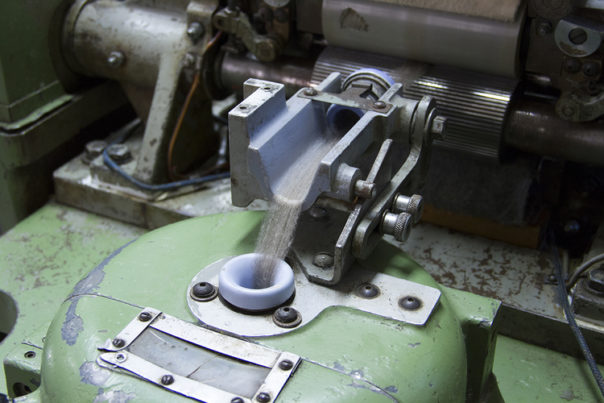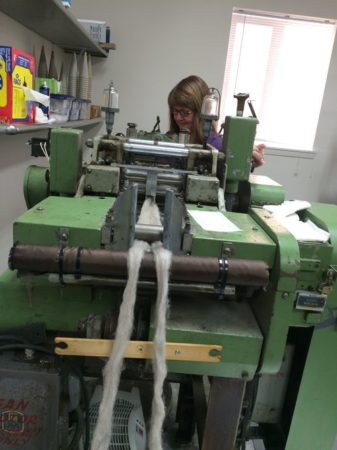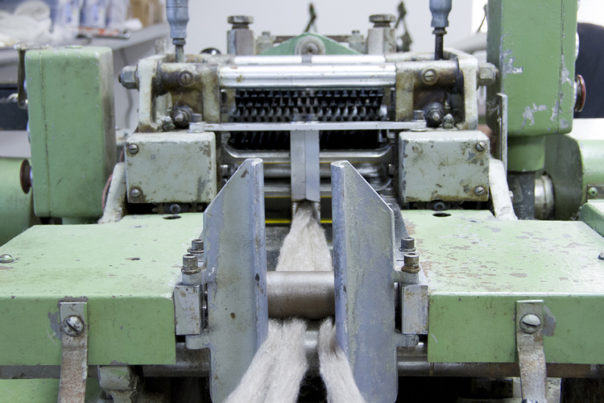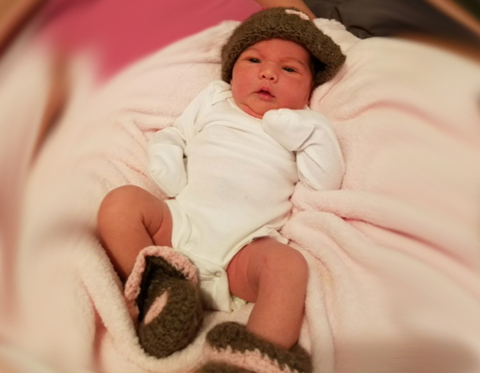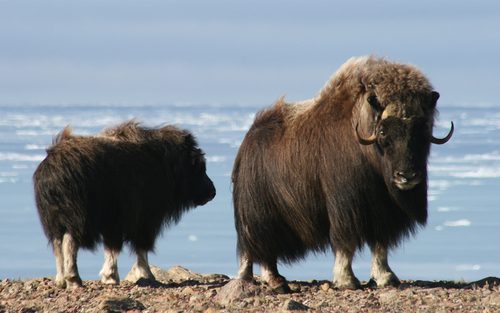Arctic Qiviut: Musk Ox And Foundation of First Commericial Fiber Mill in Alaska
Follow the story to North Pole, Alaska. Curiosity about the exquisite soft down undercoat of a muskox, a fiber known as qiviut.

Herd of musk ox.
Now that is a sight most humans will never see. Even one live musk ox in its natural environment is beyond most of us. Image via Arctic Qivuit of Alaska
Arctic Qiviut (“kiv-ee-oot”) as a brand began in 2001 as a small home-based business selling qiviut yarn and yarn wear. (Note: The story of our first contact with this exceptional product is told in a series about the fiber and results on our sister publication Moo Dog Knits, originally published 2009.)
First, some background about the animal behind this rare (for a good reason) fiber.
“Muskox naturally shed in the springtime. Qiviut wool commands a high price due to it rarity, softness, warmth and light weight. Qiviut grows from every part of the muskox including the face, belly, ears, hooves and under the horns. A mature male muskox produces around 6 to 8 pounds of muskox fleece raw fiber a year. After processing 6 pounds of muskox fleece raw fiber, you will yield about 3 to 5 pounds of cleaned qiviut fiber that is ready for spinning into yarn. Muskox grow a new layer of qiviut in the autumn.”
Farmed muskox fiber is combed out in large sheets, explains Vivian Osborne, founder and owner of Arctic Qivuit. “Qiviut from wild muskox falls off in clumps or is rubbed off by muskox on the ground or bushes. Qiviut found on the ground or bushes from wild muskox is hand collected. Wild muskox fibers are approximately 18 micrometers in diameter. Females and young animals have slightly finer wool. After the qiviut fleece is removed or collected it is cleaned by hand or machine cleaned to remove vegetation and foreign matter and then dehaired of all guard hairs. Then it is carded, pindrafted, and ready to spin into yarn. Qiviut production is extremely limited because muskox herds are few in number and are usually very remote and isolated. Qiviut yarn is eight times warmer than wool and is softer and more valuable than cashmere. Qiviut yarn and qiviut yarn blends are a knitters, crocheters and weavers dream to use to create their yarnwear.”
Now, in small batches, Osborne was finding the outsourcing to process this precious fiber for consistent quality and quantity on a timely basis to be a task. The solution? Get the equipment and establish her own mill to oversee production for super quality and deliver it to her clients to meet or beat deadlines.
“There was the challenge of finding a very large amount of funds in just a few days to check out a commercial fiber mill that was for sale in Canada,” she relates in her journey to get to her goal. “In March 2015, we flew to Manitoba Canada. We brought dehaired qiviut fiber to try on their commercial fiber milling machines. The machines passed our qiviut processing test. The spinner, pin drafter and cone winder are vintage. The carder is 8 years old. I purchased the commercial fiber milling machines.”
There remained challenges to then face and solve. Transporting mill equipment to Alaska. Finding a shipping company and crating machines for transport. Next was customs forms and fees.
“The shipping company dropped two of our vintage fiber milling machines off their truck.” To repair the broken machines, and find parts? “The companies that made the machines went out of business many years ago,” she related. “But repairing the machines helped us learn how to run them. We had no training and taught ourselves how to operate the machines. We began learning using the most challenging fiber, pure qiviut.”
Along the way, a building to house the mill was designed and built. The equipment was installed and tested to start operating and milling yarn in just six months.
The dream became reality on Jan. 24, 2016. Fully operational now, the mill produces qiviut yarns. Recently Osborne and her son traveled to Virginia and North Carolina to find other machines to add to the mill.
“Qiviut is a remarkable fiber that blooms beautifully, swelling and becoming softer the more it is handled and washed. Blending in a small amount of fine sheep wool, such as merino, will add ‘memory' to sweaters and yet will retain the wonderful softness and warmth of qiviut. Qiviut also blends well with other fibers such as angora, alpaca, cashmere, silk and nylon.”
Not a knitter? Readymade outdoor gear and fashionable headwear along with custom yarnwear is available, along with felted insoles for your boots and shoes.
More about musk ox: “Muskoxen thrive in Canada, Alaska, and Greenland. There are smaller herds in Norway and Russia. Average life span in the wild is 12 to 20 years. As herbivores, musk ox eat grass, willows, Arctic flowers, mosses, lichens, aspens, birch shoots, berry bushes, sedges, leaves, twigs – even tree bark. Muskoxen do not run from their predators, which are mainly wolves. Rather, as a defensive posture they will form a circle around the calves and fight any invaders. Males are extremely possessive of their harem of females.”
Note: An invitation to potential visitors. “if you get to North Pole in the summer, call us for a free tour – 907 490 6722.” Maybe someday.


